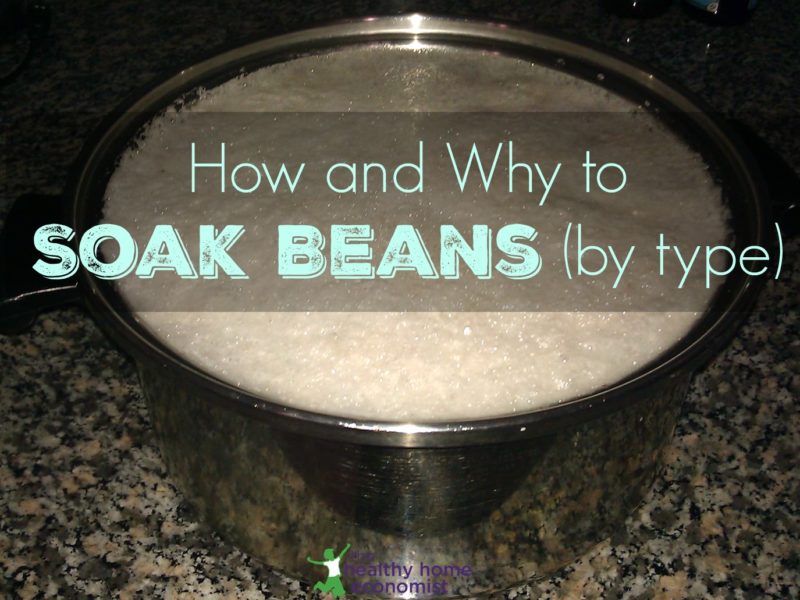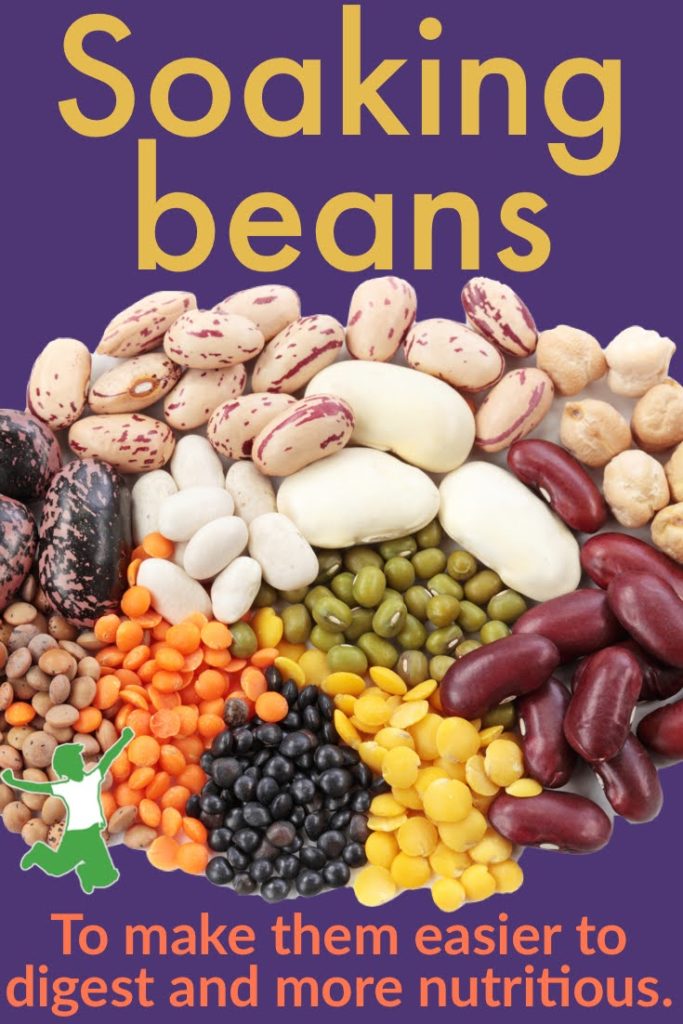Table of Contents[Hide][Show]
The simple overnight process of how to soak beans (by type) will help to eliminate gas and intestinal issues so you can enjoy eating these nutritious plant foods again!

I went on a bean soaking binge this past weekend, and the amount of scum that came to the top of the large pot of soaking kidney beans was so huge, I thought it deserved its own blog post. Soaking beans for many hours before cooking them produces a lot of scum which is course, is rinsed and drained away when the soaking is complete.
What is all that scum anyway? Anti-nutrients, that’s what! And those anti-nutrients such as phytic acid, lectins, and enzyme inhibitors are going to be in your gut causing you gas, heartburn, reflux, and whatever other digestive ills beset you when you eat something that isn’t particularly digestible unless you soak your beans before cooking them.
Traditional cultures took great care to prepare their legumes with a long soak before cooking to enhance digestibility and nutrient absorption.
I love Mexican food but really try to avoid Mexican restaurants for this reason .. they don’t soak their beans before cooking them!
After a meal at a Mexican restaurant, I will typically feel very bloated. Eating the same meal prepared at home where I soaked the beans properly before cooking results in no digestive upset whatsoever.
Take the Soaked Beans Challenge!
If you think unsoaked beans don’t cause you any trouble .. take this challenge. Soak beans next time before cooking and notice the difference in your stomach after eating.
You may think that the unsoaked beans don’t cause you any trouble, but you just may find that soaked beans are infinitely more filling and that you eat less and enjoy the meal more as a result!
Traditional peoples were very wise in the preparation of their foods. They not only selected nutritious foods but they prepared them for maximum digestibility and nutrition.
What good is eating nutritious legumes if the body is so whacked by the anti-nutrients that it can’t very easily extract and digest the nutrition?
So, the next time you make your beans, make sure you soak them first!
I soak large pots of various types of beans every month or so and then cook them – freezing for easy, quick meals when beans are required like homemade chili.
**If you absolutely do not have time to do this, at least buy pre-soaked legumes and beans packed in glass jars. Your digestion will thank you!
How To Prepare Beans by Soaking (video tutorial)
If you’ve never soaked beans before, it’s so easy. It’s a very similar process to soaking nuts. The method also mimics the wisdom of traditional societies that soaked seeds.
See this short video below that demonstrates the simple process.
Kidney shaped beans
For kidney shaped beans and dried/split peas, put a pinch of baking soda and enough water to cover in a large pot and soak uncovered for 12-24 hours. Drain, rinse and cook as usual.
Examples of kidney-shaped beans include:
- Red kidney beans
- White kidney beans (cannellini beans)
- Pinto beans
- Anasazi beans
- Black-eyed beans (black-eyed peas)
- Great Northern beans
- Lima beans
Non-kidney shaped beans (and other legumes)
For more oval-shaped beans and other legumes, soak for 12-24 hours in filtered water to cover plus 1 tablespoon of cider vinegar or lemon juice for every cup of dried beans/legumes used.
A homemade apple cider vinegar recipe or store-bought are both fine (make sure the ACV is packed in glass). Liquid whey from yogurt, kefir, or clabbered milk may also be used. Drain, rinse, and cook as usual.
Examples of non-kidney shaped beans include:
- Black beans (turtle beans)
- Navy beans
- Fava beans
- Adzuki beans
- Chickpeas
- Lentils
For maximum digestibility, it is best to rinse and refresh the filtered water and baking soda or the acidic medium once or twice during the soaking period. If you forget, no worries.
I try to always soak beans for the full 24 hours instead of just overnight. Sometimes if I get busy, I might even soak them 36 hours, but this is risky as they can get moldy sometimes if you go over 24 hours. Best to stay between 12-24 hours particularly during summer months.
How to Cook Beans After Soaking
After soaking, be sure to thoroughly drain and rinse the beans until all the scum is washed away. Then, complete the process by doing the following.
- Fill the pot of rinsed pre-soaked beans with fresh filtered water, bring to a boil, and skim away any additional foam that may come to the top at the start of the boil.
- Turn down the heat to a simmer, add 4 crushed garlic cloves, and cook until the beans are soft (about 4 hours).
- Drain beans and add to your favorite dish or let cool and freeze in large freezer bags for quick meals at a later date!
You won’t be needing over-the-counter gas meds after preparing beans the traditional way!
Should You Use the Soaking or Cooking Water?
Some alternative cooking circles advocate using the soaking or bean cooking water. Unfortunately, neither of these practices is traditional.
Using the cooked bean water or aquafaba is actually a dangerous practice. See the linked article for reasons to avoid this modern food especially during pregnancy!
Other Types of Legumes
This article plus video on soaking lentils provide additional information specifically for this legume. Because they are soaked exactly the same as all non-kidney shaped beans, it is helpful for visual learners.
Lentils were the favorite of nutritional pioneer Dr. Weston A. Price due to their very high potassium content.
Recipes Using Pre-soaked Beans and Legumes
Here are some recipes to try using soaked beans and other legumes to entice you!









I’ve wondered about fermenting- what other foods are beneficial by this processes? My grandmother use to do this with fruit for her yearly christmas fruit cakes. I’ve also read that ” real” tofu is fermented and the Western tofu isn’t fermented. I’ve avoided all soy foods as they always seemed to make me feel really sick. I’ve read a blog about a young woman who struggled with several horrible cancers and she blamed her ” healthy foods of soy” for causing it. Do you have any thoughts on this? I’d appreciate any feedback!
Sincerely
Fola
Soy is quite estrogenic and can indeed encourage cancerous growth. I myself only consume small amounts of fermented soy in the form of miso (natto and tempeh are fine too). I would suggest reading The Whole Soy Story by Dr. Daniel. Excellent read on the subject.
Sarah, I know this off the subject a little. My hubby is a diabetic 2 but a vegetarian. He was told to stay away from grains and carbs which leaves not much but soy. I generally only eat tempeh and love miso. He eats organic sprouted tofu. Any suggestions or this another post?
Eat a diet high in fruits, veggies, legumes, and small amounts of nuts/seeds. Read Dr. Fuhrman’s Eat to Live and Eat for Health books.
New research shows tat 3-5 servings of soy a day will not raise IGF levels.
Could you tell me about soaking beans in warn/hot weather? We don’t have an air conditioner & it gets up to 80 degrees plus in the house. I’ve been told that the beans can sour & become very toxic. Any thoughts on this?
Hi Patrice, I have not heard about this. I am sure a shorter soak would be fine though .. 12 hours over overnight only when the house isn’t so warm.
I am so glad I read this article, I love beans but can’t eat them because ALL beans except for green beans give me a migraine! I only have tried canned beans and didn’t kn0w they weren’t prepared right. Could this be the reason for the migraines after eating beans? Oh this goes for lima beans too, should those be soaked as well?
One more question, I don’t have access to raw milk and from reading your other articles I need that to make whey. Can I soak them with out it, will it still work?
Jill, you could make whey using storebought organic whole fat plain yogurt and straining it through a cloth-lined mesh strainer over a bowl. The liquid in the bowl is whey. And I think lima beans also need soaking. Please leave a further comment on this post if your migraines improve by soaking your beans!
Try soaking longer too. This may help with the indigestion.
Apparently, the newer and perhaps even better way is to soak them with a pinch of baking soda and no acid (kidney shaped beans only). Lentils, chickpeas, and black beans still soak in water plus cider vinegar, lemon juice, or whey.
Split peas in addition to kidney shaped beans for the baking soda. This includes navy beans, my favorite.
What would aduki beans, mung beans, and anasazi be soaked in? ACV or baking soda?
Can u use the brine from pickles or sauerkraut instead of ACV or lemon in the soak water to ferment the beans? Miso? Soy yogurt? Which works best?
How do the soaked beans stand up to having been frozen? Is the taste and texture the same?
Calgary water: ~161-206 mg/L CaCO3 (depending on N or S Calgary). I think part of the issue is our altitude (1049m)? …or it is just my sensitive gut. 😛
So, baking soda AND acid or just baking soda?
I’ve used apple cider vinegar, but apparently the newer and perhaps better way to do it is with a pinch of baking soda for kidney shaped beans. Still use acid soak for lentils, black beans, and chickpeas.
What about pinto?
Sarah,
I, too, am wondering the best way to prepare pinto beans.
Thanks 🙂
Michelle, you could try sprouting your beans after soaking. That might help. Or making sure you use baking soda instead of something acidic for kidney-shaped beans, as mentioned.
I have switched from canned to dry beans a few years back and have been trying to add more beans and whole grains to our menus. I have yet to find a good cookbook that isn’t vegan. I’m sorry, but I need a little ham in my split pea soup and veggie broth isn’t the same as a good chicken stock. Does anyone have a omnivores bean and whole grain cookbook for a person who was raised on white rice and potatoes as the only side dishes available?
Kitchen Stewardship has an entire book on beans, for traditional cooks.
She (Kitchen Stewardship) also has a grains book: “Is Your Flour Wet?”